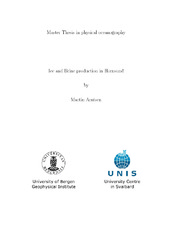Ice and brine production in Hornsund
Master thesis
Permanent lenke
https://hdl.handle.net/1956/10419Utgivelsesdato
2015-06-02Metadata
Vis full innførselSamlinger
- Geophysical Institute [1198]
Sammendrag
The Hornsund fjord system has been studied using observations of the atmosphere, ocean and sea ice, and two different types of models. The study documents significant year to year variability in sea ice formation and brine release in the fjord over the period 1978 - 2014, production of brine enriched winter water, and inflow of warmer Atlantic water in recent years. Salt production through brine release was investigated for the winter period between 1978 and 2014 using a simple one-dimensional polynya model forced with observed wind and air temperatures. Results show that easterly winds dominate in winter, often accom- panied by cold air temperature. This favour high ice production as open water is often exposed to the cold air due to the development of a polynya in the fjord. The yearly ac- cumulated heat exchange over open water is the main driver of the year to year variations in ice production. The effect of a fast ice cover restricting the polynya activity is included for the years 2006 - 2014, and results show that this reduces the magnitude in the year to year dif- ferences in salt production. This is a result of higher fast ice coverage in years of high polynya activity. In later years (2012-2014) indications of a warmer inflow is seen in the hydrographic observations, and in 2013 came into contact with the Brine enriched winter water that is trapped at depth behind the sill. The warm water will likely contribute to melting of the tide water glaciers in the fjord. Simulations using the Regional Ocean Model System (ROMS) are presented and evalu- ated towards observed hydrography and satellite observations of the ice cover. Simulations cover the period 2005- 2010 and show that inflow events generally warm the lower layer in the inner parts of the fjord before the onset of freezing.
